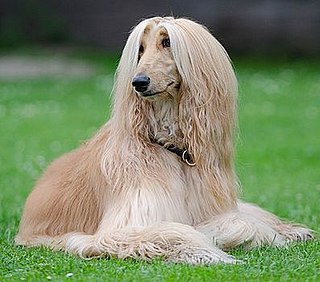
The Afghan Hound is a Hound distinguished by its thick, fine, silky coat, and a tail with a ring curl at the end. The breed is selectively bred for its unique features in the cold mountains of Afghanistan. Its local name is Tāžī Spay or Sag-e Tāzī. Other names for this breed are Tāzī, Balkh Hound, Baluchi Hound, Barakzai Hound, Shalgar Hound, Kabul Hound, Galanday Hound or sometimes incorrectly African Hound. As with other sighthounds, they have the ability to run fast and turn well.

The EnglishGreyhound, or simply the Greyhound, is a breed of dog, a sighthound which has been bred for coursing, greyhound racing and hunting. Since the rise in large-scale adoption of retired racing Greyhounds, the breed has seen a resurgence in popularity as a family pet.
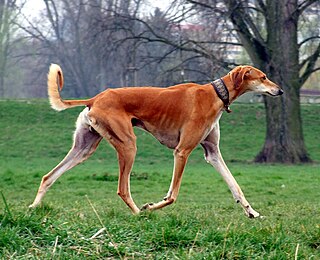
The Saluki is a standardised breed developed from sighthounds – dogs that hunt primarily by sight rather than scent – that was once used by nomadic tribes to run down game animals. The dog was originally bred in the Fertile Crescent. The modern breed is typically deep-chested and long-legged, and similar dogs appear in medieval and ancient art. The breed is most closely related to the Afghan hound, a basal breed that predates the emergence of modern breeds in the 19th century, and the Saluki has been purebred both in the Middle East, including by royalty, since at least that era, and in the West since the 1840s, though as a free-breeding landrace, similar dogs are common as feral animals in the Middle East. A related standardised breed is the north African Sloughi.
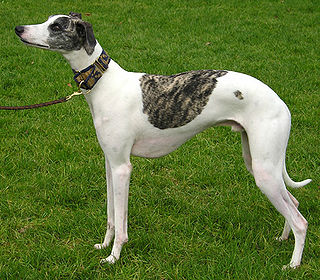
Sighthounds, also called gazehounds, are a type of dog, hounds that hunt primarily by sight and speed, rather than by scent and endurance as scent hounds do.

A hound is a type of hunting dog used by hunters to track or chase prey.

Fox hunting is an activity involving the tracking, chase and, if caught, the killing of a fox, traditionally a red fox, by trained foxhounds or other scent hounds. A group of unarmed followers, led by a "master of foxhounds", follow the hounds on foot or on horseback.
Lure coursing is a sport for dogs that involves chasing a mechanically operated lure. Competition is typically limited to dogs of purebred sighthound breeds. The AKC has a pass/fail trial for all breeds called the Coursing Ability Test (CAT) and a timed 100 yard dash called Fast CAT where the dog's speed is converted to points.
The League Against Cruel Sports, formerly known as the League for the Prohibition of Cruel Sports, is a UK-based animal welfare charity which campaigns to stop blood sports such as fox hunting, hare and deer hunting; game bird shooting; and animal fighting. The charity helped bring about the Hunting Act 2004 and Protection of Wild Mammals (Scotland) Act 2002, which banned hunting with hounds in England, Wales and Scotland.

Coursing by humans is the pursuit of game or other animals by dogs—chiefly greyhounds and other sighthounds—catching their prey by speed, running by sight, but not by scent. Coursing was a common hunting technique, practised by the nobility, the landed and wealthy, as well as by commoners with sighthounds and lurchers. In its oldest recorded form in the Western world, as described by Arrian, it was a sport practised by all levels of society, which remained the case until Carolingian period forest law appropriated hunting grounds, or commons, for the king, the nobility, and other land owners. It then became a formalised competition, specifically on hare in Britain, practised under rules, the Laws of the Leash.

The Hunting Act 2004 is an Act of the Parliament of the United Kingdom which bans the hunting of most wild mammals with dogs in England and Wales, subject to some strictly limited exemptions; the Act does not cover the use of dogs in the process of flushing out an unidentified wild mammal, nor does it affect drag hunting, where hounds are trained to follow an artificial scent.
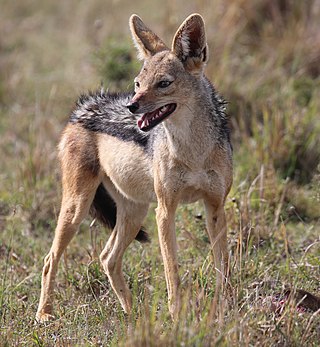
The black-backed jackal, also called the silver-backed jackal, is a medium-sized canine native to eastern and southern Africa. These regions are separated by roughly 900 kilometers.

Rabbiting is the sport of hunting rabbits. It often involves using ferrets or dogs to track or chase the prey. There are various methods used in capturing the rabbit, including trapping and shooting. Depending on where the hunting occurs, there may be licenses required and other rules in regards to methods being used.

Hare coursing is the pursuit of hares with greyhounds and other sighthounds, which chase the hare by sight, not by scent.

The golden jackal, also called common jackal, is a wolf-like canid that is native to Southeast Europe, Central Asia, Western Asia, South Asia, and regions of Southeast Asia. The golden jackal's coat varies in color from a pale creamy yellow in summer to a dark tawny beige in winter. It is smaller and has shorter legs, a shorter tail, a more elongated torso, a less-prominent forehead, and a narrower and more pointed muzzle than the Arabian wolf. It is listed as Least Concern on the IUCN Red List due to its widespread distribution and high density in areas with plenty of available food and optimum shelter.

The American Foxhound is a breed of dog, closely related to the English Foxhound. They are scent hounds, bred to hunt foxes by scent. United States Founding Father George Washington contributed to the breed's development.

The English Foxhound is one of the four foxhound breeds of dog. It is a cousin of the American Foxhound. They are scent hounds, bred to hunt foxes by scent.
Legislation on hunting with dogs is in place in many countries around the world. Legislation may regulate, or in some cases prohibit the use of dogs to hunt or flush wild animal species.
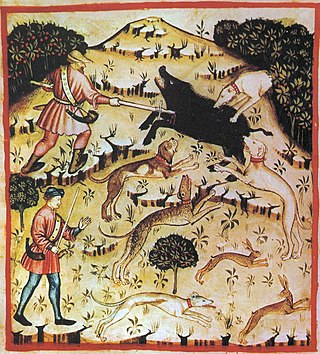
Boar hunting is the practice of hunting wild boar, feral pigs, warthogs, and peccaries. Boar hunting was historically a dangerous exercise due to the tusked animal's ambush tactics as well as its thick hide and dense bones rendering them difficult to kill with premodern weapons.

Wolf hunting with dogs is a method of wolf hunting which relies on the use of hunting dogs. While any dog, especially a hound used for hunting wolves may be loosely termed a "wolfhound", several dog breeds have been specifically bred for the purpose, some of which, such as the Irish Wolfhound, have the word in their breed name.

Tesem was the ancient Egyptian name for "hunting dog". In popular literature it denotes the prick-eared, leggy dog with a curled tail from the early Egyptian age, but it was also used with reference to the lop-eared "Saluki/Sloughi" type. It was one of several types of dogs in Ancient Egypt; particularly the latter Saluki/Sloughi type of Tesem, having the appearance most similar to that of a true sighthound.

















